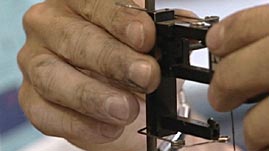When engineers prepare to design something, be it a skyscraper, a cell
phone, or a bicycle, they follow certain steps that we call the design
process. The design process provides general direction when engineers
set out to solve problems. By working through these steps sequentially,
they increase the odds that their concepts will work when built.
Identify the Challenge. You need to recognize the
heart of any problem before attempting to solve it. You must also
know the constraints placed upon you. Are there any size, weight, or
budget limitations? Will the structure need to support a fixed amount
of weight, or will the load vary according to how many people or cars
are on it? Once you know just what you are trying to accomplish, you can
continue forward.Research and Brainstorm. Research
all that's related to the challenge at hand, like the site conditions,
materials available, and public opinion. Has the challenge been met
before? If so, how? If not, why not? Then, because the best solution
to a problem is not always the first idea conceived, exchange ideas
in an open forum. To spark creativity, let the invited participants
know that there is no such thing as a bad idea, no matter how crazy it
may seem.Design a Solution. Once you've settled
on an idea to develop, prepare detailed drawings and engineering plans
and solicit feedback. These designs may need to be modified depending
on any feedback you receive.Test Ideas. The only
way to know if your design will work in real-world conditions is to
build a model, or prototype, and then test it. If it's a building,
will it stand up against wind and weather? What about gravity? If it's
a large passenger ship, will it float?Evaluate. If
your initial design doesn't fully solve the problem or meet the challenge
(or can't do so for the money you have to spend), go back and repeat the
above steps. You'll know what doesn't work and be in a better position
to develop an idea that does. If your design does solve the problem,
then it's on to the final step.Build It!


 Loading Standards
Loading Standards Teachers' Domain is proud to be a Pathways portal to the National Science Digital Library.
Teachers' Domain is proud to be a Pathways portal to the National Science Digital Library.
